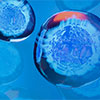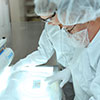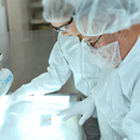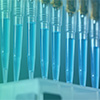BIOTIUM
Lieferant:
Biotium
Beschreibung:
Anti-IgG Donkey Polyclonal Antibody (CF™ 543)
Lieferant:
Biotium
Beschreibung:
Anti-IgG Donkey Polyclonal Antibody (CF™ 770)
Lieferant:
Biotium
Beschreibung:
Anti-IgG Rabbit Polyclonal Antibody (CF™ 543)
Lieferant:
Biotium
Beschreibung:
Goat anti-human IgA reacts specifically with IgA heavy chains (α chains) and not with immunoglobulin light chains. To minimize crossreactivity, it has been adsorbed human IgG prior to conjugation. This conjugate is labeled with CF™633 dye. CF™ dyes offer advantages in brightness, photostability, and specificity compared to other fluorescent dyes. Far-red fluorescent CF™633 (Ex/Em 630/650 nm) produces brighter antibody conjugates than Alexa Fluor® 647, and has unmatched photostability.
Alexa Fluor® is a registered trademark of Thermo Fisher Scientific. Cy®5 is a registered trademark of GE Healthcare. Alexa Fluor® and Texas Red® are registered trademarks of Thermo Fisher Scientific. Alexa Fluor® is a registered trademark of Thermo Fisher Scientific.
Lieferant:
Biotium
Beschreibung:
This conjugate is prepared by labeling F(ab’)2 fragment of goat anti-rabbit IgG (H+L) with CF™350 dye. CF™ dyes offer advantages in brightness, photostability, and specificity compared to other fluorescent dyes. Blue fluorescent CF™350 (Ex/Em 347/448 nm) is more water-soluble, more photostable and at least 50% more fluorescent on proteins compared to the traditional blue dye AMCA.
Lieferant:
Biotium
Beschreibung:
This conjugate is prepared by labeling F(ab’)2 fragment of goat anti-rabbit IgG (H+L) with CF™633 dye. CF™ dyes offer advantages in brightness, photostability, and specificity compared to other fluorescent dyes. Far-red fluorescent CF™633 (Ex/Em 630/650 nm) produces brighter antibody conjugates than Alexa Fluor® 647, and has unmatched photostability.
Alexa Fluor® is a registered trademark of Thermo Fisher Scientific. Cy®5 is a registered trademark of GE Healthcare.
Lieferant:
Biotium
Beschreibung:
Recognizes a protein of 130-140 kDa, identified as CD22 (also known as BL-CAM). CD22 expression is restricted to normal and neoplastic B cells and is absent from other haemopoietic cell types. In B-cell ontogeny, CD22 is first expressed in the cytoplasm of pro-B and pre-B cells, and on the surface as B cells mature to become IgD . It is not expressed by plasma cells, CD22 is found highly expressed in follicular mantle and marginal zone B-cells, and while germinal center B-cells are relatively weak. CD22 is a member of the immunoglobulin superfamily and serves as an adhesion receptor for sialic acid-bearing ligands expressed on erythrocytes and all leukocyte classes. It also associates with tyrosine kinases and play a role in signal transduction and B-cell activation.
Artikel-Nr:
(BNUM0553-50)
Lieferant:
Biotium
Hersteller-Artikelnummer::
BNUM0553-50
Lokale Artikelnummer::
BTIUBNUM0553-50
Beschreibung:
Recognizes a protein of 55 kDa, identified as CD14 (also known lipopolysaccharide receptor). CD14 is expressed strongly on monocytes and macrophage and weakly on the surface of neutrophils. CD14 is anchored to cells by linkage to glycosylphosphatidylinositol (GPI) and functions as a high affinity receptor for complexes of LPS and LPS binding protein (LBP). Soluble CD14, also binding to LPS, acts at physiological concentration as an LPS agonist and has, at higher concentrations, an LPS antagonizing effect in cell activation.
VE:
1 * 50 µl
Lieferant:
Biotium
Beschreibung:
Recognizes a protein of 18-35 kDa, identified as CD90 (also known as Thy1). CD90 is a member of the immunoglobulin superfamily. It may contribute to inhibition of proliferation/differentiation of hematopoietic stem cells and neuron memory formation in the CNS. It consists of a single Ig domain (112 amino acids; 25-35 kDa) inserted into the cell membrane via a GPI anchor. Expressed by hematopoietic stem cells and neurons in all species studied. Its highly expressed in connective tissue and various fibroblast and stromal cell lines, expressed on all thymocytes and peripheral T cells in mice, but in humans expressed only on small % fetal thymocytes, 10-40% of CD34 cells in bone marrow, and <1% of CD3 CD4 lymphocytes in peripheral circulation. It is also expressed by human lymph node HEV endothelium but not other endothelia. Lastly, it is expressed by a limited number of lymphoblastoid and leukemic cell lines.
Lieferant:
Biotium
Beschreibung:
Recognizes a protein of 18-35 kDa, identified as CD90 (also known as Thy1). CD90 is a member of the immunoglobulin superfamily. It may contribute to inhibition of proliferation/differentiation of hematopoietic stem cells and neuron memory formation in the CNS. It consists of a single Ig domain (112 amino acids; 25-35 kDa) inserted into the cell membrane via a GPI anchor. Expressed by hematopoietic stem cells and neurons in all species studied. Its highly expressed in connective tissue and various fibroblast and stromal cell lines, expressed on all thymocytes and peripheral T cells in mice, but in humans expressed only on small % fetal thymocytes, 10-40% of CD34 cells in bone marrow, and <1% of CD3 CD4 lymphocytes in peripheral circulation. It is also expressed by human lymph node HEV endothelium but not other endothelia. Lastly, it is expressed by a limited number of lymphoblastoid and leukemic cell lines.
Lieferant:
Biotium
Beschreibung:
Twenty human keratins are resolved with two-dimensional gel electrophoresis into acidic (pI 6.0) subfamilies. This antibody recognizes acidic (Type I or LMW) and basic (Type II or HMW) cytokeratins, including 59 kDa (CK4); 58 kDa (CK5); 56 kDa (CK6); 52 kDa (CK8); 56.5 kDa (CK10); 53 kDa (CK13) and 45 kDa (CK18). This is a broad-spectrum antibody, which has been reported to differentiate epithelial tumors from non-epithelial tumors. Many studies have shown the usefulness of keratins as markers in cancer research and tumor diagnosis.
Lieferant:
Biotium
Beschreibung:
Recognizes a protein of 12 kDa, identified as β-2 microglobulin. Major histocompatibility complex (MHC) class 1 molecules bind to antigens for presentation on the surface of cells. The proteasome is responsible for producing these antigens from the components of foreign pathogens. MHC class 1 molecules consist of an α heavy chain that contains three subdomains (α1, α2, α3) and a non-covalent associating light chain, known as β-2-Microglobulin. β-2-Microglobulin associates with the α3 subdomain of the α heavy chain and forms an immunoglobulin domain-like structure that mediates proper folding and expression of MHC class 1 molecules. The α1 and α2 domains of the α heavy chain form the peptide antigen-binding cleft. Mutations in the β-2-Microglobulin gene can enhance the progression of malignant melanoma phenotypes.
Lieferant:
Biotium
Beschreibung:
Recognizes a protein of 21 kDa, identified as the Bax protein. This MAb is highly specific to Bax and shows no cross-reaction with Bcl-2 or Bcl-X protein. Bcl-2 blocks cell death following a variety of stimuli. Bax has extensive amino acid homology with Bcl-2 and it homodimerizes and forms heterodimers with Bcl-2. Overexpression of Bax accelerates apoptotic death induced by cytokine deprivation in an IL-3 dependent cell line, and Bax also counters the death repressor activity of Bcl-2.
Lieferant:
Biotium
Beschreibung:
Recognizes a protein of 12 kDa, identified as β-2 microglobulin. Major histocompatibility complex (MHC) class 1 molecules bind to antigens for presentation on the surface of cells. The proteasome is responsible for producing these antigens from the components of foreign pathogens. MHC class 1 molecules consist of an α heavy chain that contains three subdomains (α1, α2, α3) and a non-covalent associating light chain, known as β-2-Microglobulin. β-2-Microglobulin associates with the α3 subdomain of the α heavy chain and forms an immunoglobulin domain-like structure that mediates proper folding and expression of MHC class 1 molecules. The α1 and α2 domains of the α heavy chain form the peptide antigen-binding cleft. Mutations in the β-2-Microglobulin gene can enhance the progression of malignant melanoma phenotypes.
Lieferant:
Biotium
Beschreibung:
This MAb recognizes human 17-26 kDa protein, which is identified as cytokine TNF-alpha (Tumor Necrosis Factor-alpha). TNF-alpha can be expressed as a 17 kDa free molecule, or as a 26 kDa membrane protein. TNF-alpha is a protein secreted by lipopolysaccharide-stimulated macrophages, and causes tumor necrosis when injected into tumor bearing mice. TNF alpha is believed to mediate pathogenic shock and tissue injury associated with endotoxemia. TNF alpha exists as a multimer of two, three, or five non-covalently linked units, but shows a single 17 kDa band following SDS PAGE under non-reducing conditions. TNF alpha is closely related to the 25 kDa protein Tumor Necrosis Factor beta (lymphotoxin), sharing the same receptors and cellular actions. TNF alpha causes cytolysis of certain transformed cells, being synergistic with interferon gamma in its cytotoxicity. Although it has little effect on many cultured normal human cells, TNF alpha appears to be directly toxic to vascular endothelial cells. Other actions of TNF alpha include stimulating growth of human fibroblasts and other cell lines, activating polymorphonuclear neutrophils and osteoclasts, and induction of interleukin 1, prostaglandin E2 and collagenase production. TNF alpha is currently being evaluated in treatment of certain cancers and AIDS Related Complex.
Lieferant:
Biotium
Beschreibung:
S100 belongs to the family of calcium binding proteins. S100A and S100B proteins are two members of the S100 family. S100A is composed of an alpha and beta chain whereas S100B is composed of two beta chains. S-100 protein has been found in normal melanocytes, Langerhans cells, histiocytes, chondrocytes, lipocytes, skeletal and cardiac muscle, Schwann cells, epithelial and myoepithelial cells of the breast, salivary and sweat glands, as well as in glial cells. Neoplasms derived from these cells also express S-100 protein, albeit non-uniformly. A large number of well-differentiated tumors of the salivary gland, adipose and cartilaginous tissue, and Schwann cell-derived tumors express S-100 protein. Almost all malignant melanomas and cases of histiocytosis X are positive for S-100 protein. Despite the fact that S-100 protein is an ubiquitous substance, its demonstration is of great value in the identification of several neoplasms, particularly melanomas and their metastases.
Preis auf Anfrage
Lager für diesen Artikel ist begrenzt, kann aber in einem Lagerhaus in Ihrer Nähe zur Verfügung. Bitte stellen Sie sicher, dass Sie in sind angemeldet auf dieser Seite, so dass verfügbare Bestand angezeigt werden können. Wenn das
Lager für diesen Artikel ist begrenzt, kann aber in einem Lagerhaus in Ihrer Nähe zur Verfügung. Bitte stellen Sie sicher, dass Sie in sind angemeldet auf dieser Seite, so dass verfügbare Bestand angezeigt werden können. Wenn das
Dieses Produkt kann nur an eine Lieferadresse versandt werden die über die entsprechende Lizenzen verfügt. Für weitere Hilfe bitte kontaktieren Sie Ihr VWR Vertriebszentrum.
-Additional Documentation May be needed to purchase this item. A VWR representative will contact you if needed.
Dieses Produkt wurde von Ihrer Organisation gesperrt. Bitte kontaktieren Sie Ihren Einkauf für weitere Informationen.
Dieses Produkt ist Ersatz für den von Ihnen gewünschten Artikel.
Dieses Produkt ist nicht mehr verfügbar. Bitte kontaktieren Sie den VWR Kundenservice.
|
|||||||||

















































